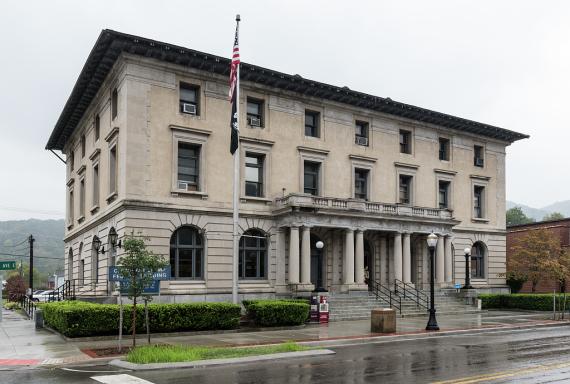Location: 322 Wood Ave E, Big Stone Gap, VA 24219
The C. Bascom Slemp Federal Building in Big Stone Gap, Virginia is situated in the center of the small, commercial downtown at the southwest corner of Wood Avenue and East Fourth Street. Designed as a U.S. Post Office and Courthouse, the building was completed in 1912. Since its construction, the federal building has served as a vital local landmark. The building is named for C. Bascom Slemp, U.S. Congressman representing Virginia’s 9th congressional district from 1907 to 1923, Secretary to the President for Calvin Coolidge in 1923 and 1924, and distinguished local figure who had grown up in Big Stone Gap.
The three-story hipped-roofed building was designed under Treasury Department Supervising Architect James Knox Taylor in the Second Renaissance Revival style, a style popular in the early years of the twentieth century. The formal composition relied on the unity of parts, monumental scale, symmetry, rhythm, and classical ornamentation for its architectural effect. The parts of the building were clearly defined and each elevation carefully proportioned to create a dignified and solid character. Although smaller and less ornate than other examples of period federal buildings, the Big Stone Gap building exhibited the monumentality and solidarity associated with the style.
The small town of Big Stone Gap was just twenty-five years old (incorporated in 1888) when the construction of the federal building began. The town was named for the surrounding mountainous region, sited on a gap in the Stone Mountain between the Powell River and the South Fork of the Powell River. The town economy was established and grew based on the presence nearby of what was believed to be a vein of remarkably pure iron (which later turned out to be not very pure and quite hard to access) and on the nearby coal deposits. An iron furnace was erected in the area c. 1891. 1891 also saw the arrival of two rail lines, which ran to depots about a mile from town. To bridge this distance, a small dummy railroad was established to bring passengers and freight into the center of town. This railroad running near the center of town ran down the center of Wood Avenue and is seen in early photos of the federal building. The town boomed for a few years, but soon the bubble burst, before recovering in the early 1900s.
By the turn of the century, population growth spurred the need for a new post office and courthouse, and in 1904, an act of Congress established a United States District Court in Big Stone Gap. A temporary court facility was set up on the second floor of the Goodloe Building, across the street from the present site of the federal building. The first mention of plans for construction of a post office and courthouse in Big Stone Gap appeared in the 1908 Annual Report of the Supervising Architect. Two additional acts of Congress in 1909 and 1911 appropriated budgeted funds for the site and construction of the federal building: $100,000 for the construction and $15,000 for the site. Four lots were purchased from two private joint owners in June 1909 for a total of $6,000. The site offered a 132-foot frontage on Wood Avenue and East Fourth Street.
The design and construction documents for the building were executed under the direction of James Knox Taylor, the Supervising Architect for the U.S. Treasury Department from 1897 to 1912. The Big Stone Gap building was under construction in 1912, Taylor’s final year in office. James A. Wetmore, the acting Supervising Architect (1912-1913) and Oscar Wenderoth, the next Supervising Architect (1913-1915), both supervised the completion of the building.
The C. Bascom Slemp Federal Building was listed in the National Register of Historic Places on December 23, 1975. The federal building remains a significant component of the central business district today and still functions as an active post office and houses federal offices. After a period of infrequent court use during the 1970s, the building became an active courthouse again during the 1990s, but has once again reverted to intermittent use during the 2010s as the judge for the region elected to focus court activities in Abingdon, sixty miles to the east.
Facts
- Architect: Taylor, James Knox
- Construction Dates: 1911-1912
- GSA Building Number: VA0020ZZ
- Landmark Status: Listed in the National Register of Historic Places

 U.S. General Services Administration
U.S. General Services Administration
